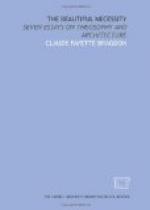“As is the small, so is the great” is a perpetually recurring phrase in the literature of theosophy, and naturally so, for it is a succinct statement of a fundamental and far-reaching truth. The scientist recognizes it now and then and here and there, but the occultist trusts it always and utterly. To him the microcosm and the macrocosm are one and the same in essence, and the forth-going impulse which calls a universe into being and the indrawing impulse which extinguishes it again, each lasting millions of years, are echoed and repeated in the inflow and outflow of the breath through the nostrils, in nutrition and excretion, in daily activity and nightly rest, in that longer day which we name a lifetime, and that longer rest in Devachan—and so on until time itself is transcended.
[Illustration 23]
In the same way, in nature, a thing is echoed and repeated throughout its parts. Each leaf on a tree is itself a tree in miniature, each blossom a modified leaf; every vertebrate animal is a complicated system of spines; the ripple is the wave of a larger wave, and that larger wave is a part of the ebbing and flowing tide. In music this law is illustrated in the return of the tonic to itself in the octave, and its partial return in the dominant; also in a more extended sense in the repetition of a major theme in the minor, or in the treble and again in the bass, with modifications perhaps of time and key. In the art of painting the law is exemplified in the repetition with variation of certain colors and combinations of lines in different parts of the same picture, so disposed as to lead the eye to some focal point. Every painter knows that any important color in his picture must be echoed, as it were, in different places, for harmony of the whole.
[Illustration 24]
In the drama the repetition of a speech or of an entire scene, but under circumstances which give it a different meaning, is often most effective, as when Gratiano, in the trial scene of The Merchant of Venice taunts Shylock with his own words, “A Daniel come to judgment!” or, as when in one of the later scenes of As You Like It an earlier scene is repeated, but with Rosalind speaking in her proper person and no longer as the boy Ganymede.
These recurrences, these inner consonances, these repetitions with variations are common in architecture also. The channeled triglyphs of a Greek Doric frieze echo the fluted columns below (Illustration 24). The balustrade which crowns a colonnade is a repetition, in some sort, of the colonnade itself. The modillions of a Corinthian cornice are but elaborated and embellished dentils. Each pinnacle of a Gothic cathedral is a little tower with its spire. As Ruskin has pointed out, the great vault of the cathedral nave, together with the pointed roof above it, is repeated in the entrance arch with its gable, and the same two elements appear in every statue-enshrining




